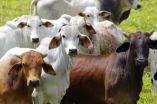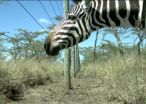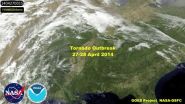(Press-News.org) A graduate student in Semel Institute for Neuroscience and Human Behavior, and two of his undergraduate trainees, were selected by the Council on Undergraduate Research to present their original research on Capitol Hill in Washington, D.C., on Tuesday.
Wesley Kerr, whose graduate studies will be completed in the UCLA Department of Biomathematics, and his trainees, Akash Patel and Sarah Barritt, will present their poster entitled "Computer-Aided Diagnosis of Epilepsy Using Clinical Information" outlining advances in the use of computational machine learning to help clinicians detect and diagnose epilepsy correctly.
"This is very exciting," Kerr said of the selection to participate. "It's always nice to get exposure for our work."
The Posters on the Hill exhibit typically picks just one or two research projects per state to participate in the prestigious event, said Mark Cohen, Kerr's faculty advisor and a professor-in-residence of psychiatry in the Semel Institute for Neuroscience and Human Behavior.
"A large fraction of patients with seizure disorder are misdiagnosed and treated inappropriately," Cohen said. "As such treatments carry their own risks and negative side effects, their research could positively affect the lives of millions of Americans."
The goal of Kerr's team was to estimate the probability of epilepsy versus non-epileptic seizures based on the historical factors reported by the patient to their neurologist.
Distinguishing between epileptic and non-epileptic seizures is a challenge, Kerr said. On average, the time from the first seizure to the diagnosis of non-epileptic seizures is seven years. In the meantime, a majority of those patients are misdiagnosed with epilepsy and treated inappropriately with anti-epileptic medications.
"This can expose patients to serious, and potentially fatal, side effects," Kerr said. "One of our laboratory's goals is to create an automated system that can aid physicians in distinguishing patients with epileptic and non-epileptic seizures."
Kerr and his team accomplished this by inspecting outpatient clinical notes from patients with medication-resistant seizure disorder, who were later diagnosed as having epilepsy or non-epileptic seizure disorder, using the gold standard diagnostic assessment, 72- hour in-patient closed circuit video-electroencephalography (VEEG) monitoring.
Using a combination of the known risk factors for epilepsy and non-epileptic seizures reported in 228 clinical notes the team examined, their algorithm achieved a diagnosis accuracy of 65%. While at first glance this may appear low, it is comparable to the accuracy of neurologists prior to VEEG monitoring. In this work, they used a machine learning method known as a "decision tree."
"The structure of our decision tree also provided meaningful information about the interpretation of each risk factor in each patient. For example, the risk factors for non-epileptic seizures may not be the same for women and men," Kerr said. "This work may help diagnose, and thereby more effectively treat, patients that are in need."
In addition to serving patients with seizure disorder, the computer-aided diagnostic methods developed by Kerr and his team may be applicable to the diagnosis of other maladies in the future.
As part of their trip, Patel, Barritt and Kerr will take meetings in the offices of California state senators and representatives. They will use this forum to emphasize the importance of appropriate diagnosis in epilepsy and the academic environment at UCLA that made this research possible.
INFORMATION:The researched was funded by the National Institutes of Health (R33 DA026109, NIH R90 DA022768, T32 GM08042, T32 GM008185, T90 DA023422) and the William M. Keck Foundation, as well as the UCLA Department of Biomathematics.
UCLA research team selected to present original epilepsy research on Capitol Hill
2014-04-28
ELSE PRESS RELEASES FROM THIS DATE:
Mystery of the pandemic flu virus of 1918 solved by University of Arizona researchers
2014-04-28
A study led by Michael Worobey at the University of Arizona in Tucson provides the most conclusive answers yet to two of the world's foremost biomedical mysteries of the past century: the origin of the 1918 pandemic flu virus and its unusual severity, which resulted in a death toll of approximately 50 million people.
Worobey's paper on the flu, to be published in the early edition of the Proceedings of the National Academy of Sciences (PNAS) on April 28, not only sheds light on the devastating 1918 pandemic, but also suggests that the types of flu viruses to which people ...
Success really does breed success, unique online experiments find
2014-04-28
Success really does breed success – up to a point - found researchers from UCL and Stony Brook University, following a series of unique on-line experiments.
For decades, it has been observed that similar people experience divergent success trajectories, with some repeatedly succeeding and others repeatedly failing. Some suggest initial success can catalyse further achievements, creating a positive feedback loop, while others attribute a string of successes to inherent talent. To test these views the researchers conducted four experiments that measured the impact of experimental ...
How Brazilian cattle ranching policies can reduce deforestation
2014-04-28
Berkeley — There is a higher cost to steaks and hamburgers than what is reflected on the price tags at grocery stores and restaurants. Producing food – and beef, in particular – is a significant source of greenhouse gas emissions, which are projected to grow as rising incomes in emerging economies lead to greater demands for meat.
But an encouraging new study by researchers at the University of California, Berkeley, and international collaborators finds that policies to support sustainable cattle ranching practices in Brazil could put a big dent in the beef and food ...
Brazilian agricultural policy could cut global greenhouse gas emissions
2014-04-28
Brazil may be able to curb up to 26% of global greenhouse gas emissions from deforestation by encouraging the intensification of its cattle production, according to a new study from researchers at the International Institute for Applied Systems Analysis (IIASA) and international collaborators.
The study, published in the journal Proceedings of the National Academy of Sciences, showed that by subsidizing semi-intensive pasture-based cattle production or taxing conventional pastures Brazil may be able to deliver a substantial cut in global greenhouse gas emissions, even ...
Oxytocin promotes social behavior in infant rhesus monkeys
2014-04-28
The hormone oxytocin appears to increase social behaviors in newborn rhesus monkeys, according to a study by researchers at the National Institutes of Health, the University of Parma in Italy, and the University of Massachusetts Amherst. The findings indicate that oxytocin is a promising candidate for new treatments for developmental disorders affecting social skills and bonding.
Oxytocin, a hormone produced by the pituitary gland, is involved in labor and birth and in the production of breast milk. Studies have shown that oxytocin also plays a role in parental bonding, ...
Scientists identify antibodies against deadly emerging disease
2014-04-28
Scientists at Dana-Farber Cancer Institute have identified natural human antibodies against the virus that causes Middle East Respiratory Syndrome (MERS), a step toward developing treatments for the newly emerging and often-fatal disease.
Currently there is no vaccine or antiviral treatment for MERS, a severe respiratory disease with a mortality rate of more than 40 percent that was first reported in Saudi Arabia in 2012.
In laboratory studies reported in the Proceedings of the National Academy of Sciences (PNAS), the researchers found that these "neutralizing" antibodies ...
Study: Tart cherry juice increases sleep time in adults with insomnia
2014-04-28
SAN DIEGO, Calif. April 28, 2014 – A morning and evening ritual of tart cherry juice may help you sleep better at night, suggests a new study presented today at the Experimental Biology 2014 meeting. Researchers from Louisiana State University found that drinking Montmorency tart cherry juice twice a day for two weeks helped increase sleep time by nearly 90 minutes among older adults with insomnia.
These findings were presented Monday, April 28, at the "Dietary Bioactive Components: Antioxidant and Anti-inflammatory Effects of Dietary Bioactive Components" section of ...
Decrease in large wildlife drives an increase in rodent-borne disease and risk to humans
2014-04-28
Populations of large wildlife are declining around the world, while zoonotic diseases (those transmitted from animals to humans) are on the rise. A team of Smithsonian scientists and colleagues have discovered a possible link between the two. They found that in East Africa, the loss of large wildlife directly correlated with a significant increase in rodents, which often carry disease-causing bacteria dangerous to humans. The team's research is published in the Proceedings of the National Academy of Sciences, April 28.
"Our study shows us that ecosystem health, wildlife ...
Smart home programming: Easy as 'if this, then that'
2014-04-28
PROVIDENCE, R.I. [Brown University] — The idea of a smart home sounds promising enough. Who doesn't want a house full of automated gadgets — from light switches to appliances to heating systems — that know exactly when to turn on, turn off, heat up or power down?
But in order for all those devices to do what they're supposed to do, they'll need to be programed — a task the average homeowner might not have the interest or the tech-savvy to perform. And nobody wants to call tech support just to turn on a light.
A group of computer science researchers from Brown and Carnegie ...
Satellite movie shows US tornado outbreak from space
2014-04-28
VIDEO:
This animation of NOAA's GOES-East satellite data shows the development and movement of the weather system that spawned tornadoes affecting seven central and southern US states on Apr. 27-28, 2014....
Click here for more information.
NASA has just released an animation of visible and infrared satellite data from NOAA's GOES-East satellite that shows the development and movement of the weather system that spawned tornadoes affecting seven central and southern U.S. states ...







